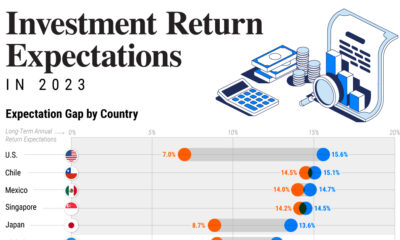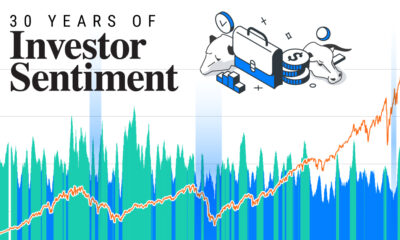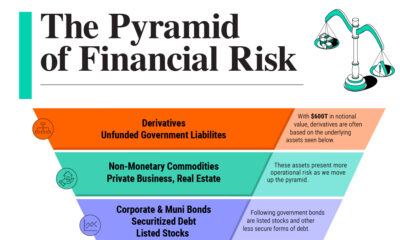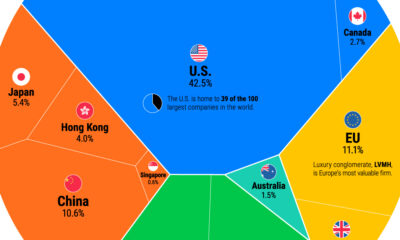This infographic is available as a poster.
Chart: The Rise of Stock Buybacks Over 20 Years
Despite market turbulence, stock buybacks are on track to hit record levels by year-end.
Spurring this wave of buybacks are strong corporate cash flows—sitting near $2 trillion—and a 1% excise tax on buybacks approaching in 2023. This signals a vote of confidence from corporations on their financial health even as a recession looms large.
In this Markets in a Minute from New York Life Investments, we chart the growth of buybacks over the last two decades and the implications for investors looking ahead.
How Stock Buybacks Work
In stock buybacks, corporations buy their own shares from existing shareholders. This reduces the number of shares in the market and boosts earnings per share. Often, this can increase share prices given the rise in earnings growth.
It was not until 1982 that share repurchases became legal, driving wider usage among corporations as a capital allocation tool.
By comparison, dividends are another common form of distributing capital back to shareholders.
Dividends are bound by strict policies and do not offer the same tax advantages and flexibility as buybacks. While dividends are taxed as income, buybacks are taxed as capital gains—making them a preferential choice for investors. Given these advantages, stock buybacks have outpaced dividends over the last two decades.
In fact, in the third quarter of 2022, an estimated one in five companies in the S&P 500 Index conducted buybacks that in turn increased their earnings per share by at least 4% year-over-year.
Stock Buyback Trends
As the below table shows, stock buybacks in the S&P 500 Index outnumber dividends by about double in 2022:
| Year | S&P 500 Stock Buybacks | S&P 500 Dividends |
| 2022* | $1.00T | $0.54T |
| 2021 | $0.88T | $0.51T |
| 2020 | $0.52T | $0.48T |
| 2019 | $0.73T | $0.49T |
| 2018 | $0.81T | $0.46T |
Source: S&P Dow Jones Indices (Sep 2022). *For the 12-months ending June 2022.
However, stock buybacks fluctuate more often than dividends since corporations can turn them on or off. For example, in 2020, buybacks sharply declined given growing financial uncertainty. Meanwhile, companies issued dividends at a steady pace.
In this way, when share prices decline, buybacks typically decrease.
Yet unlike the last two recessions in 2008 and 2020, buybacks have shown notable strength in 2022 in spite of falling share prices.
What Are the Top Sectors for Stock Buybacks?
We can see in the table below that the biggest share repurchasers are in the tech sector, with $2.1 trillion in buybacks since 2009.
| Sector | Cumulative Buybacks Since 2009 | Q2 Buybacks |
| Information Technology | $2,060.4B | $72.0B |
| Financials | $1,265.0B | $21.2B |
| Consumer Discretionary | $941.7B | $27.6B |
| Health Care | $929.1B | $17.2B |
| Industrials | $717.6B | $17.4B |
| Consumer Staples | $548.1B | $10.7B |
| Communication Services | $369.6B | $29.4B |
| Energy | $337.9B | $13.4B |
| Materials | $187.0B | $8.7B |
| Utilities | $26.8B | $0.5B |
| Real Estate | $16.9B | $1.1B |
| Total | $7,382.6B | $219.6B |
Source: Yardeni Research (Nov 2022). Represents stock buybacks for S&P 500 Index sectors.
On the other hand, utilities and other capital-intensive sectors tend to spend less on buybacks in contrast to asset-light sectors such as tech and financials.
What is also characteristic to share buybacks is their concentration. As we have seen in the second quarter this year, the top 20% of buybacks make up 47% of all repurchases across the S&P 500 Index.
New Tax On Stock Buybacks
Stock buybacks have drawn criticism for using cash to benefit shareholders instead of boosting production or improving the quality of the business.
In response, beginning in 2023, the Inflation Reduction Act puts a 1% excise tax on buybacks.
What this means is that public companies based in the U.S. must now pay a 1% tax on share repurchases, which could result in millions of additional expenses. Given this new tax rule, corporations may be accelerating buybacks ahead of year-end.
Implications for Investors
As stock buybacks have grown in prominence, it’s worth noting that not all are equal.
When a buyback aligns with a company’s long-term plan, and the company can cover their operational expenses, it can support the stability and growth of the company. When stock prices are volatile, companies can repurchase shares when they are undervalued.
By contrast, if a company takes on excess leverage in order to buyback shares, it can contribute to lower financial resilience. When a company uses a buyback to opportunistically repurchase shares, the boost in share prices may be short-lived.
In addition, it could also prevent capital from being directed to growth initiatives. In this way, it’s important to consider stock buybacks on a case-by-case basis.
With this in mind, investors can look to companies with healthy balance sheets that can weather economic storms. Here, companies that illustrate price discipline and buy back shares at a discount may help build long-term value, providing benefits to investors who stay the course.




 Infographics2 years ago
Infographics2 years ago
 Markets in a Minute2 years ago
Markets in a Minute2 years ago
 Markets in a Minute2 years ago
Markets in a Minute2 years ago
 Infographics2 years ago
Infographics2 years ago
 Markets in a Minute1 year ago
Markets in a Minute1 year ago
 Infographics3 years ago
Infographics3 years ago
 Markets in a Minute2 years ago
Markets in a Minute2 years ago
 Infographics1 year ago
Infographics1 year ago




















